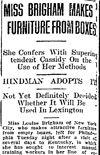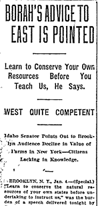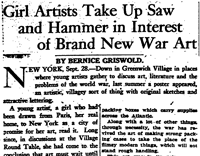Today's Do-It-Yourself movement is peopled with crafty types who revel in finding creative ways to reuse things instead of simply throwing the old stuff out and buying new. Evidence of this movement can be found in the popularity of ReadyMade Magazine's MacGyver Challenges; in Ikeahacker's celebration of imaginative consumers who adapt the often bland goods sold by that international chain; and in Wardrobe Refashion's encouragement to those inclined toward re-interpreting and re-thinking the value of "pre-loved" clothes.
Why do some of us go through the trouble of reusing old things instead of simply buying new? The answers vary, but common motives include environmentalism, thrift, artistic expression and a desire to find alternatives to disposable consumption. This "stewardship of objects"1 once played a much more prominent role in everyday peoples' lives, as each person mended, made do and cajoled objects into lasting as long as possible at a time when material goods were not as easily obtained as they are today. (For more on the truly fascinating history of the "stewardship of objects," read Susan Strasser's Waste and Want.) And even if today's repurposing efforts are not the result of scarcity of goods, this practice plays an important part in the story of America's material culture. One hundred years ago, Louise Brigham's box furniture played a part as well.
Louise Brigham was an American artist, carpenter and social worker active in the early decades of the 20th century. After studying art, she became an active worker in the settlement house movement, operating Sunshine Cottage in Cleveland, Ohio. She later traveled throughout Europe, observing and learning the traditional handicraft skills of different countries and cultures, and her interest in teaching handicraft skills played a large part in her social work.2
It was the combination of her interests in social work and in handicraft that led Brigham to conceive of the idea of low-cost, attractive furniture made from cast-off shipping boxes. Although she had experimented with box furniture in Cleveland, she perfected her craft at a remote coal mining camp in Finland where, as she explained in her book Box Furniture, she designed and built all of her furniture from leftover shipping boxes (one of the only sources of lumber available). Upon her return to the United States, she settled in New York and began to promote her box furniture method through educational programs as well as through a book devoted to the subject.3
Brigham's book, Box Furniture, was first published in 1909 and—through successive printings—quickly spread her thrifty furniture gospel far and wide. The New York Times reported that Box Furniture might "be taken as one of the few indications of the birth in this country of a tendency toward less wastefulness of raw material."4 Brigham's furniture designs, with their right angles and rigid box-like aesthetic, were also noted for their reflection of the popular Mission style, and her work received favorable attention in national magazines like Craftsman and Ladies' Home Journal as well.5
Readers of Box Furniture (and would-be carpenters) would find that Brigham categorized her designs by how the boxes were to be used: "kept in its original form" (chapter 1) or "turned upon its side, with the cover and sometimes the sides removed" (chapter 7), for example. She provided instructions for making everything from a pipe rack to a hanging lantern, a kitchen table to a clock case, a wall desk to a bedstead, a footstool to an office file. Each project described specified the required boxes (a gelatin box, for example, was required to make an upright clock case). Other boxes called for include beef boxes, condensed milk boxes, carbonite boxes, shoe boxes, canned fruit boxes, butter boxes and soap boxes, to name just a few.6
Brigham's book included illustrations of room interiors showing her box furniture in a variety of spaces—nursery, den, living room, twin bed room, college boy's corner, kitchen, office, boy's room, school room, bedroom, studio, invalid's room, dining room, club room and library or study. But Brigham wanted more than just illustrations to show interested social workers, designers and artists, so she created model rooms as well. One such model was her own apartment in New York, which she furnished entirely with box furniture, at a total cost of just $4.20—this at a time when just one factory-made item of furniture could cost a week's earnings.7 She also took part in New York's 1911 Child Welfare Exhibit, creating a model room called "Room Delightful" for a child that featured her box furniture as well as plants and pictures that were inexpensive yet "in perfect taste."8
Beyond her book and model rooms, she also sought to teach boys (although by World War I young women were included as well)9 how to make their own inexpensive, handcrafted furniture. In New York City, she founded the Home Thrift Association in 1911 with the mission of providing these youngsters with the means and skills necessary to furnish their own homes thriftily. The "laboratory," as she called her carpentry shop, was headquartered in the then-empty Gracie Mansion (which later became the mayor's residence). Here, boys would gather after school to work on their furniture projects; once completed, items would be taken to the amateur carpenters' own homes.10
Brigham's box furniture designs and teaching methods spread beyond New York, as other American city school systems studied her designs and her "laboratory" for application in their own local institutions.11 Her furniture designs and the Home Thrift Association were the culmination of her studies, artistic inclinations, travels and settlement house experiences. Through box furniture, she had succeeded in her mission to show "how the needs of a home may be practically and artistically met at a minimum expense through the utilization of the cast-off."12
So no matter where one's own crafty recycling resourcefulness leads, Louise Brigham would have no doubt been pleased to know that today's do-it-yourselfers are finding thrifty, enterprising ways of reusing cast-off objects in unexpected ways. As she loftily exclaimed in Box Furniture, "To all who care for simplicity and thrift, utility and beauty, I send my message."13
Footnotes:
1 Strasser, Susan. Waste and Want: A Social History of Trash. New York: Henry Holt, 1999. p. 21.
2 "Louise Chisholm, Crafts Expert, 81." New York Times, March 31, 1956.
3 Gelber, Steven M. Hobbies: Leisure and the Culture of Work in America. New York: Columbia University Press, 1999. p. 212.
4 "A Book of Boxes." New York Times, June 5, 1909.
5 Gelber, p. 211-212.
6 Brigham, Louise. Box Furniture: How to Make a Hundred Useful Articles for the Home. New York: The Century Co., 1909.
7 Gelber, p. 212.
8 "Borah's Advice to East is Pointed: Learn to Conserve Your Own Resources before You Teach Us, He Says." Morning Oregonian, January 5, 1911.
9 "What Women Are Doing to Help Win the War: Girl Artists Take Up Saw and Hammer in Interest of Brand New War Art." Cleveland Plain Dealer, Sept. 29, 1918.
10 "Teaching Boys to Make Good Furniture Out of Boxes." New York Times, January 19, 1913.
11 "Miss Brigham Makes Furniture from Boxes." Lexington Herald, September 22, 1909.
12 Brigham, p. 4.
13 Brigham, p. 5.







